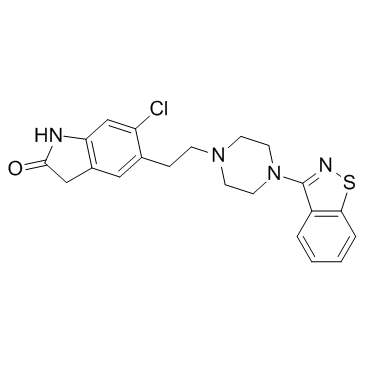Ziprasidone

Ziprasidone structure
|
Common Name | Ziprasidone | ||
|---|---|---|---|---|
| CAS Number | 146939-27-7 | Molecular Weight | 412.94 | |
| Density | 1.4±0.1 g/cm3 | Boiling Point | 554.8±50.0 °C at 760 mmHg | |
| Molecular Formula | C21H21ClN4OS | Melting Point | 213-215°C | |
| MSDS | N/A | Flash Point | 289.3±30.1 °C | |
| Symbol |



GHS02, GHS07, GHS08 |
Signal Word | Danger | |
|
Gingival pain: an unusual side effect of ziprasidone.
BMJ Case Rep. 2013 , doi:10.1136/bcr-2012-007577, (2013) The patient is a 52-year-old man with schizophrenia who developed severe, unremitting gingival pain after his ziprasidone dosage was increased from 80 to 120 mg. His physical examination and laboratory findings were unremarkable. He did not have any extra-pyr... |
|
|
A thorough QTc study of 3 doses of iloperidone including metabolic inhibition via CYP2D6 and/or CYP3A4 and a comparison to quetiapine and ziprasidone.
J. Clin. Psychopharmacol. 33(1) , 3-10, (2013) The potential for iloperidone, a D2/5-HT2A antipsychotic, to affect the heart rate-corrected QT interval (QTc) was assessed in the absence and presence of metabolic inhibitors in a randomized, open-label, multicenter study. QT interval prolongation by medicat... |
|
|
Association between second-generation antipsychotics and changes in body mass index in adolescents.
J. Adolesc. Health 52(3) , 336-43, (2013) To assess the association of second-generation antipsychotics (SGAs) with changes in body mass index (BMI) among adolescents compared with a matched untreated comparison group.A retrospective cohort study was conducted using an electronic medical record datab... |
|
|
Noninferiority of perphenazine vs. three second-generation antipsychotics in chronic schizophrenia.
J. Nerv. Ment. Dis. 202(1) , 18-24, (2014) Noninferiority analysis is a statistical method of growing importance in comparative effectiveness research that has rarely been used in psychopharmacology. This method is used here to evaluate whether first-generation antipsychotics are clinically not inferi... |
|
|
Aripiprazole versus other atypical antipsychotics for schizophrenia.
Cochrane Database Syst. Rev. 2 , CD006569, (2013) In most western industrialised countries, second generation (atypical) antipsychotics are recommended as first line drug treatments for people with schizophrenia. In this review we specifically examine how the efficacy and tolerability of one such agent - ari... |
|
|
Enhanced ziprasidone combination therapy effectiveness in obese compared to nonobese patients with bipolar disorder.
J. Clin. Psychopharmacol. 32(6) , 814-9, (2012) To assess longer-term ziprasidone effectiveness in obese and non-obese patients with bipolar disorder (BD).Outpatients assessed with the Systematic Treatment Enhancement Program for BD Affective Disorders Evaluation and monitored with the Systematic Treatment... |
|
|
Assessment of propofol, midazolam and ziprasidone, or the combinations for the prevention of acute cocaine toxicity in a mouse model.
Environ. Toxicol. Pharmacol. 35(1) , 61-6, (2013) To evaluate the effects of pretreatment, midazolam (M), propofol (P), ziprasidone (Z), and two combinations of [(midazolam plus propofol (MP); midazolam plus ziprasidone (MZ)] in mice models in the prevention of seizures, and death due to acute cocaine toxici... |
|
|
Haloperidol for psychosis-induced aggression or agitation (rapid tranquillisation).
Cochrane Database Syst. Rev. 11 , CD009377, (2012) Haloperidol, used alone is recommended to help calm situations of aggression with people with psychosis. This drug is widely accessible and may be the only antipsychotic medication available in areas where resources are limited.To investigate whether haloperi... |
|
|
Intramuscular ziprasidone versus haloperidol for managing agitation in Chinese patients with schizophrenia.
J. Clin. Psychopharmacol. 33(2) , 178-85, (2013) Intramuscular (IM) antipsychotics are preferred for efficient control of agitation symptoms. Previous studies have demonstrated that IM ziprasidone is efficacious and safe for treatment of agitation in schizophrenia. However, clinicians now recognize that rac... |
|
|
A case of catatonia in a 14-year-old girl with schizophrenia treated with electroconvulsive therapy.
Z. Kinder. Jugendpsychiatr. Psychother. 41(1) , 69-74, (2013) This article presents a case of a 14-year-old female twin with schizophrenia who developed severe catatonia following treatment with olanzapine. Under a combined treatment with amantadine, electroconvulsive therapy (ECT), and (currently) ziprasidone alone she... |